Stress Characteristics of Horizontal-Axis Wind Turbine Blades under Dynamic Yaw
Abstract
1. Introduction
2. Numerical Model
2.1. Structural Dynamics Model
2.2. Computational Domain and Yawed Flow
2.3. Computational Grid and Numerical Method
3. Results and Discussion
3.1. Wind Turbine Thrust and Power Characteristics
3.2. Analysis of Stress Characteristics
3.2.1. Analysis of Blade Surface Stress
3.2.2. Analysis of Stress in the Wingspan Direction
- At a tip speed ratio of 4, the stress of downwind deflection was greater than that of upwind deflection within one deflection period, except at −25° and −5° yaw angles. There was a significant difference in the stresses of downwind and upwind deflections for a particular yaw angle, and the stress of upwind deflection was always greater than that of downwind deflection at other yaw angles.
- At a tip speed ratio of 5, the downwind yaw stress was less than the headwind yaw stress at yaw angles of −20° and 15°, and the differences in stress at a given yaw angle within a yaw period were inconspicuous.
- At a tip speed ratio of 6, the stress of downwind deflection was less than that of headwind deflection at yaw angles of −10°, 10°, 20°, and 25°. At one yaw angle, downwind deflection stresses were greater than headwind deflection stresses, and the stress differential between downwind and headwind deflection stresses rose steadily.
4. Conclusions
Author Contributions
Funding
Institutional Review Board Statement
Informed Consent Statement
Data Availability Statement
Conflicts of Interest
References
- Chu, L.K. The role of energy security and economic complexity in renewable energy development: Evidence from G7 countries. Environ. Sci. Pollut. Res. 2023, 30, 56073–56093. [Google Scholar] [CrossRef]
- Zhao, J.; Dong, K.; Dong, X.; Shahbaz, M. How renewable energy alleviate energy poverty? A global analysis. Renew. Energy 2022, 186, 299–311. [Google Scholar] [CrossRef]
- Younis, M.A.A.; Quteishat, A. Selection of wind turbine systems for the sultanate of oman. Comput. Syst. Sci. Eng. 2023, 45, 343–359. [Google Scholar] [CrossRef]
- Kumar, A.; Pal, D.; Kar, S.K.; Mishra, S.K.; Bansal, R. An overview of wind energy development and policy initiatives in India. Clean Technol. Environ. Policy 2022, 24, 1337–1358. [Google Scholar] [CrossRef] [PubMed]
- Zhang, J.; Wang, H. Development of offshore wind power and foundation technology for offshore wind turbines in China. Ocean Eng. 2022, 266, 113256. [Google Scholar] [CrossRef]
- Tian, W.; Ozbay, A.; Hu, H. A wind tunnel study of wind loads on a model wind turbine in atmospheric boundary layer winds. J. Fluids Struct. 2019, 85, 17–26. [Google Scholar] [CrossRef]
- Morăraș, C.I.; Goanță, V.; Husaru, D.; Istrate, B.; Bârsănescu, P.D.; Munteanu, C. Analysis of the effect of fiber orientation on mechanical and elastic characteristics at axial stresses of GFRP used in wind turbine blades. Polymers 2023, 15, 861. [Google Scholar] [CrossRef]
- Mohammadi, M.; Bastankhah, M.; Fleming, P.; Churchfield, M.; Bossanyi, E.; Landberg, L.; Ruisi, R. Curled-Skewed Wakes behind Yawed Wind Turbines Subject to Veered Inflow. Energies 2022, 15, 9135. [Google Scholar] [CrossRef]
- Ahmadi, M.H.B.; Yang, Z. Wake Structure in Yawed Approaching Flows for an Axial-Flow Wind Turbine. ASME. J. Eng. Gas Turbines Power 2022, 144, 111016. [Google Scholar] [CrossRef]
- Dai, J.; Yang, X.; Yang, W.; Gao, G.; Li, M. Further Study on the Effects of Wind Turbine Yaw Operation for Aiding Active Wake Management. Appl. Sci. 2020, 10, 1978. [Google Scholar] [CrossRef]
- Li, X.; Qiu, Y.; Feng, Y.; Wang, Z. Wind turbine power prediction considering wake effects with dual laser beam LiDAR measured yaw misalignment. Appl. Energy 2021, 299, 117308. [Google Scholar] [CrossRef]
- Ali, Q.S.; Kim, M.H. Unsteady aerodynamic performance analysis of an airborne wind turbine under load varying conditions at high altitude. Energy Convers. Manag. 2020, 210, 112696. [Google Scholar] [CrossRef]
- Song, K.; Kang, Y. A Numerical Performance Analysis of a Rim-Driven Turbine in Real Flow Conditions. J. Mar. Sci. Eng. 2022, 10, 1185. [Google Scholar] [CrossRef]
- Li, Z.; Wen, B.; Dong, X.; Peng, Z.; Qu, Y.; Zhang, W. Aerodynamic and aeroelastic characteristics of flexible wind turbine blades under periodic unsteady inflows. J. Wind Eng. Ind. Aerodyn. 2020, 197, 104057. [Google Scholar] [CrossRef]
- Song, K.; Wang, W.Q.; Yan, Y. The hydrodynamic performance of a tidal-stream turbine in shear flow. Ocean Eng. 2020, 199, 107035. [Google Scholar]
- Ye, Z.; Wang, X.; Chen, Z.; Wang, L. Unsteady aerodynamic characteristics of a horizontal wind turbine under yaw and dynamic yawing. Acta Mech. Sin. 2020, 36, 320–338. [Google Scholar] [CrossRef]
- Wang, X.; Ye, Z.; Kang, S.; Hu, H. Investigations on the Unsteady Aerodynamic Characteristics of a Horizontal-Axis Wind Turbine during Dynamic Yaw Processes. Energies 2019, 12, 3124. [Google Scholar] [CrossRef]
- Ye, Z.L.; Wang, X.D.; Yin, Z.M.; Wang, L. Unsteady Aerodynamic Characteristics of Wind Turbine Under Dynamic Yaw. J. Eng. Thermophys. 2019, 40, 565–572. [Google Scholar]
- Wen, B.; Tian, X.; Dong, X.; Peng, Z.; Zhang, W.; Wei, K. A numerical study on the angle of attack to the blade of a horizontal-axis offshore floating wind turbine under static and dynamic yawed conditions. Energy 2019, 168, 1138–1156. [Google Scholar] [CrossRef]
- Ke, S.; Yu, W.; Wang, T.; Ge, Y. Aerodynamic performance and wind-induced effect of large-scale wind turbine system under yaw and wind-rain combination action. Renew. Energy 2019, 136, 235–253. [Google Scholar] [CrossRef]
- Ke, S.; Wang, T.; Ge, Y.; Wang, H. Wind-induced fatigue of large HAWT coupled tower-blade structures considering aeroelastic and yaw effects. Struct. Des. Tall Spec. Build. 2018, 27, e1467. [Google Scholar] [CrossRef]
- Wang, W.; Matsubara, T.; Hu, J.; Odahara, S.; Nagai, T.; Karasutani, T.; Ohya, Y. Experimental investigation into the influence of the flanged diffuser on the dynamic behavior of CFRP blade of a shrouded wind turbine. Renew. Energy 2015, 78, 386–397. [Google Scholar] [CrossRef]
- Dai, L.; Yao, S.; Wang, X.; Kang, S. Fluid-structure interaction performance of wind turbine blade under yawed condition. Acta Energiae Solaris Sin. 2017, 38, 945–950. [Google Scholar]
- Zhang, J.W.; Wang, J.W.; Yan, S.J. The effect of yaw speed and delay time on power generation and stress of a wind turbine. Int. J. Green Energy 2022, 20, 153–165. [Google Scholar] [CrossRef]
- Meng, H.; Lien, F.S.; Glinka, G.; Geiger, P. Study on fatigue life of bend-twist coupling wind turbine blade based on anisotropic beam model and stress-based fatigue analysis method. Compos. Struct. 2019, 208, 678–701. [Google Scholar] [CrossRef]
- Tohid Bagherpour, T.; Li, X.M.; Manolas, D.I.; Riziotis, V. Modeling of material bend-twist coupling on wind turbine blades. Compos. Struct. 2018, 193, 237–246. [Google Scholar] [CrossRef]
- Boujleben, A.; Ibrahimbegovic, A.; Lefrançois, E. An efficient computational model for fluid-structure interaction in application to large overall motion of wind turbine with flexible blades. Appl. Math. Model. 2020, 77, 392–407. [Google Scholar] [CrossRef]
- Liu, L.; Bian, H.; Du, Z.; Xiao, C.; Guo, Y.; Jin, W. Reliability analysis of blade of the offshore wind turbine supported by the floating foundation. Compos. Struct. 2019, 211, 287–300. [Google Scholar] [CrossRef]
- Zhang, C.; Chen, H.; Huang, T. Fatigue damage assessment of wind turbine composite blades using corrected blade element momentum theory. Measurement 2018, 129, 102–111. [Google Scholar] [CrossRef]
- Chen, X. Experimental Investigation on Structural Collapse of a Large Composite Wind Turbine Blade under Combined Bending and Torsion. Compos. Struct. 2017, 160, 435–445. [Google Scholar] [CrossRef]
- Chen, X.; Tang, J.; Yang, K. Modeling multiple failures of composite box beams used in wind turbine blades. Compos. Struct. 2019, 217, 130–142. [Google Scholar] [CrossRef]
- Stanciu, M.D.; Nastac, S.M.; Tesula, I. Prediction of the Damage Effect on Fiberglass-Reinforced Polymer Matrix Composites for Wind Turbine Blades. Polymers 2022, 14, 1471. [Google Scholar] [CrossRef]
- Ye, J.; Chu, C.; Cai, H.; Hou, X.; Shi, B.; Tian, S.; Chen, X.; Ye, J. A multi-scale model for studying failure mechanisms of composite wind turbine blades. Compos. Struct. 2019, 212, 220–229. [Google Scholar] [CrossRef]
- Baqersad, J.; Niezrecki, C.; Avitabile, P. Full-field dynamic strain prediction on a wind turbine using displacements of optical targets measured by stereophotogrammetry. Mech. Syst. Signal Process. 2015, 62–63, 284–295. [Google Scholar] [CrossRef]
- Baqersad, J.; Niezrecki, C.; Avitabile, P. Extracting full-field dynamic strain on a wind turbine rotor subjected to arbitrary excitations using 3D point tracking and a modal expansion technique. J. Sound Vib. 2015, 352, 16–29. [Google Scholar] [CrossRef]
- Wu, R.; Zhang, D.; Yu, Q.; Jiang, Y.; Arola, D. Health monitoring of wind turbine blades in operation using three-dimensional digital image correlation. Mech. Syst. Signal Process. 2019, 130, 470–483. [Google Scholar] [CrossRef]
- Haselbach, P.U. An advanced structural trailing edge modelling method for wind turbine blades. Compos. Struct. 2017, 180, 521–530. [Google Scholar] [CrossRef]
- Fernandez, G.; Usabiaga, H.; Vandepitte, D. An efficient procedure for the calculation of the stress distribution in a wind turbine blade under aerodynamic loads. J. Wind Eng. Ind. Aerodyn. 2018, 172, 42–54. [Google Scholar] [CrossRef]
- Santo, G.; Peeters, M.; Van Paepegem, W.; Degroote, J. Dynamic load and stress analysis of a large horizontal axis wind turbine using full scale fluid-structure interaction simulation. Renew. Energy 2019, 140, 212–226. [Google Scholar] [CrossRef]
- Jiang, Y.; Liu, S.; Zao, P.; Yu, Y.; Zou, L.; Liu, L.; Li, J. Experimental evaluation of a tree-shaped quad-rotor wind turbine on power output controllability and survival shutdown capability. Appl. Energy 2022, 309, 1183505. [Google Scholar] [CrossRef]
- Liew, J.; Lio, W.H.; Urbán, A.M.; Holierhoek, J.; Kim, T. Active tip deflection control for wind turbines. Renew. Energy 2019, 149, 445–454. [Google Scholar] [CrossRef]
- Collet, D.; Alamir, M.; Di Domenico, D.; Sabiron, G. Data-driven fatigue-oriented MPC applied to wind turbines Individual Pitch Control. Renew. Energy 2021, 170, 1008–1019. [Google Scholar] [CrossRef]
- Farag, W.; El-Hosary, M.; Kamel, A. Analysis of Various Yaw Control Techniques for Large Wind Turbines. J. Eng. Res. 2019, 7, 215–231. [Google Scholar]
- Chen, W.; Liu, H.; Lin, Y.; Li, W.; Sun, Y.; Zhang, D. LSTM-NN Yaw Control of Wind Turbines Based on Upstream Wind Information. Energies 2020, 13, 1482. [Google Scholar] [CrossRef]
- Toosi, M.E.N.; Rahmati, M. A Novel Wake Control Approach for Power Generation Improvement of Three Wind Turbines in a Wind Farm. ASME. J. Eng. Gas Turbines Power 2022, 144, 121001. [Google Scholar] [CrossRef]
- Wang, J.; Jia, R.; Wu, K.; Wang, J. Effects of a tip vane on pressure distribution of wind turbine blade. J. Eng. Thermophys. 2006, 27, 760–762. [Google Scholar]
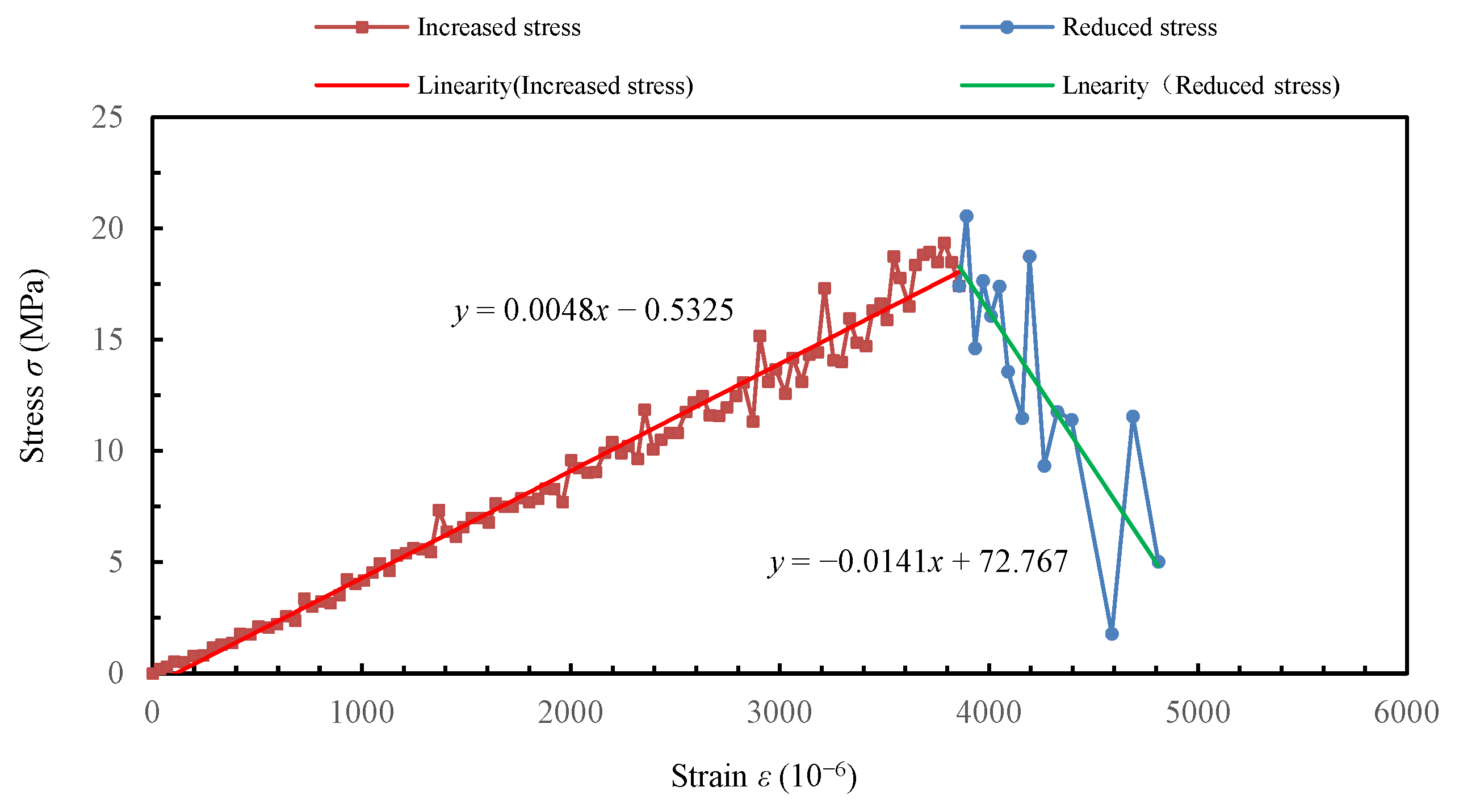
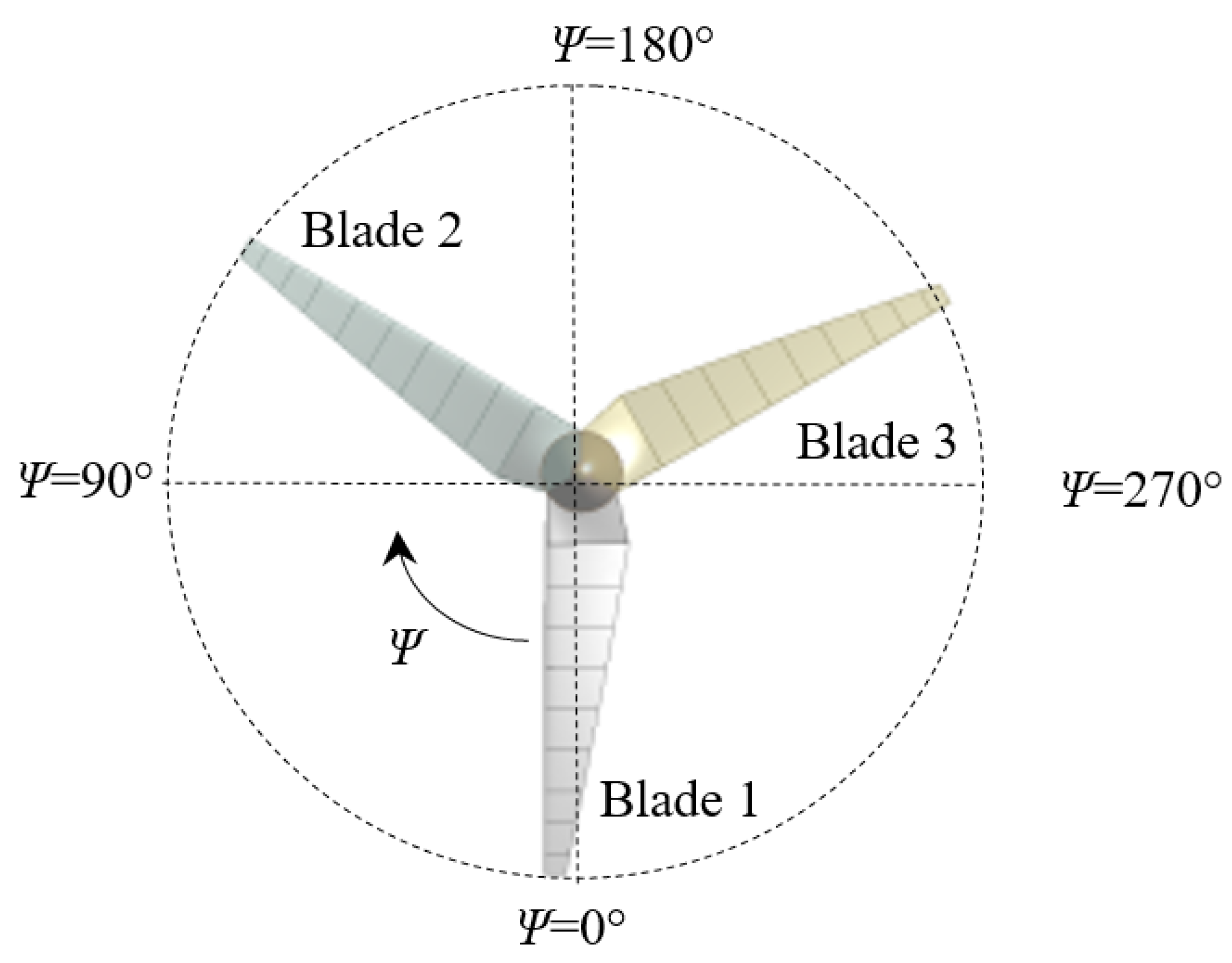
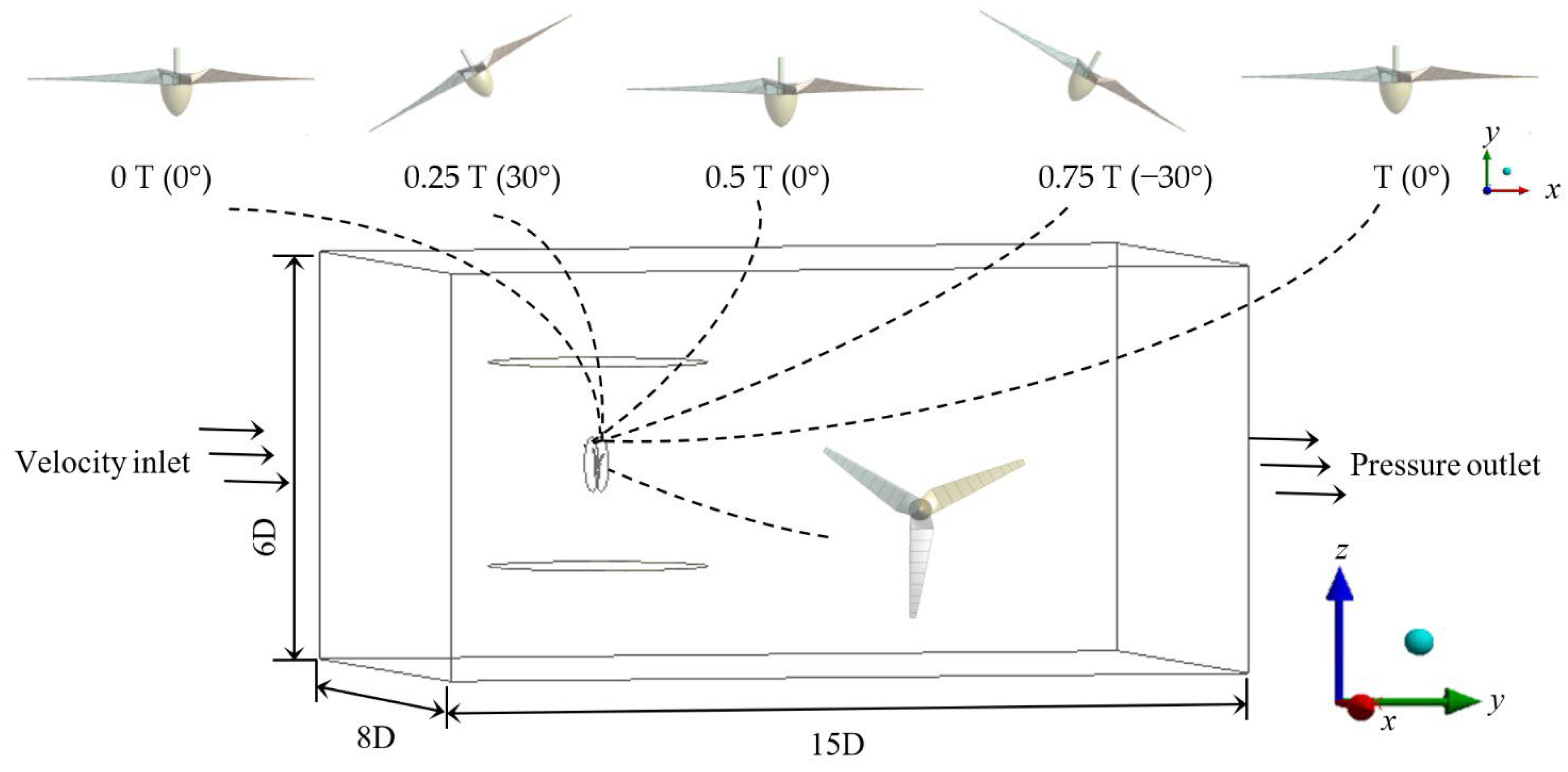
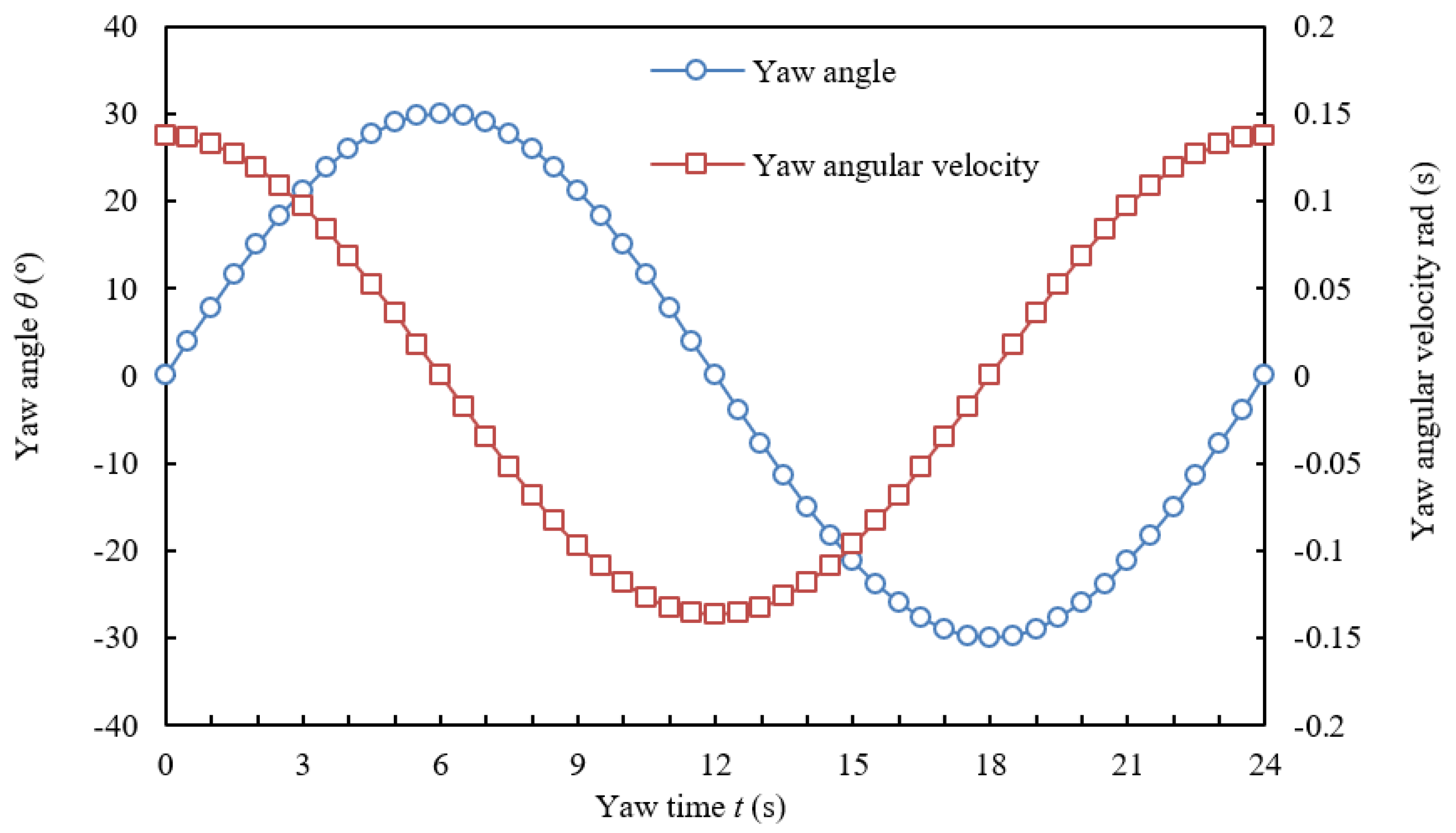


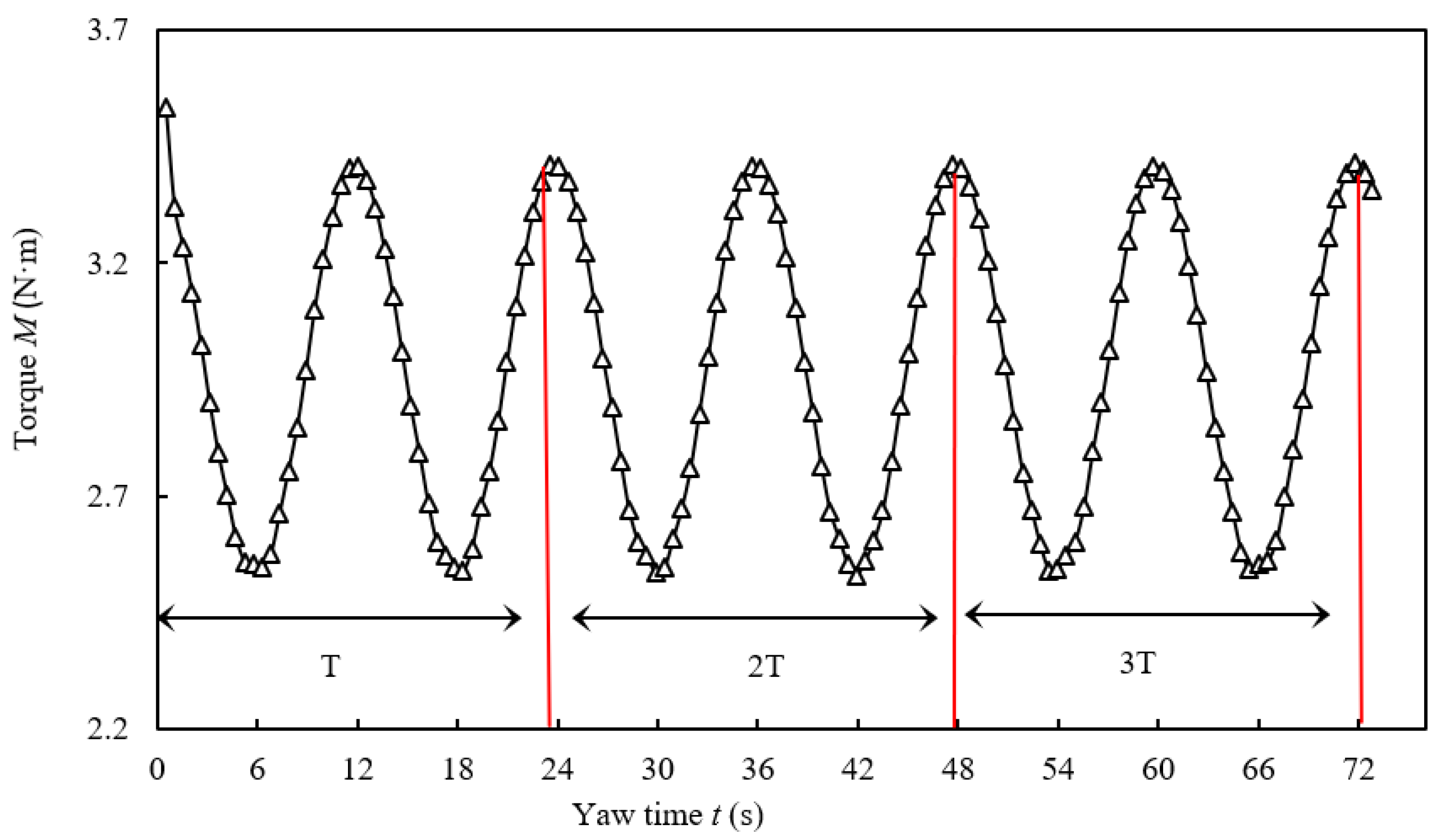

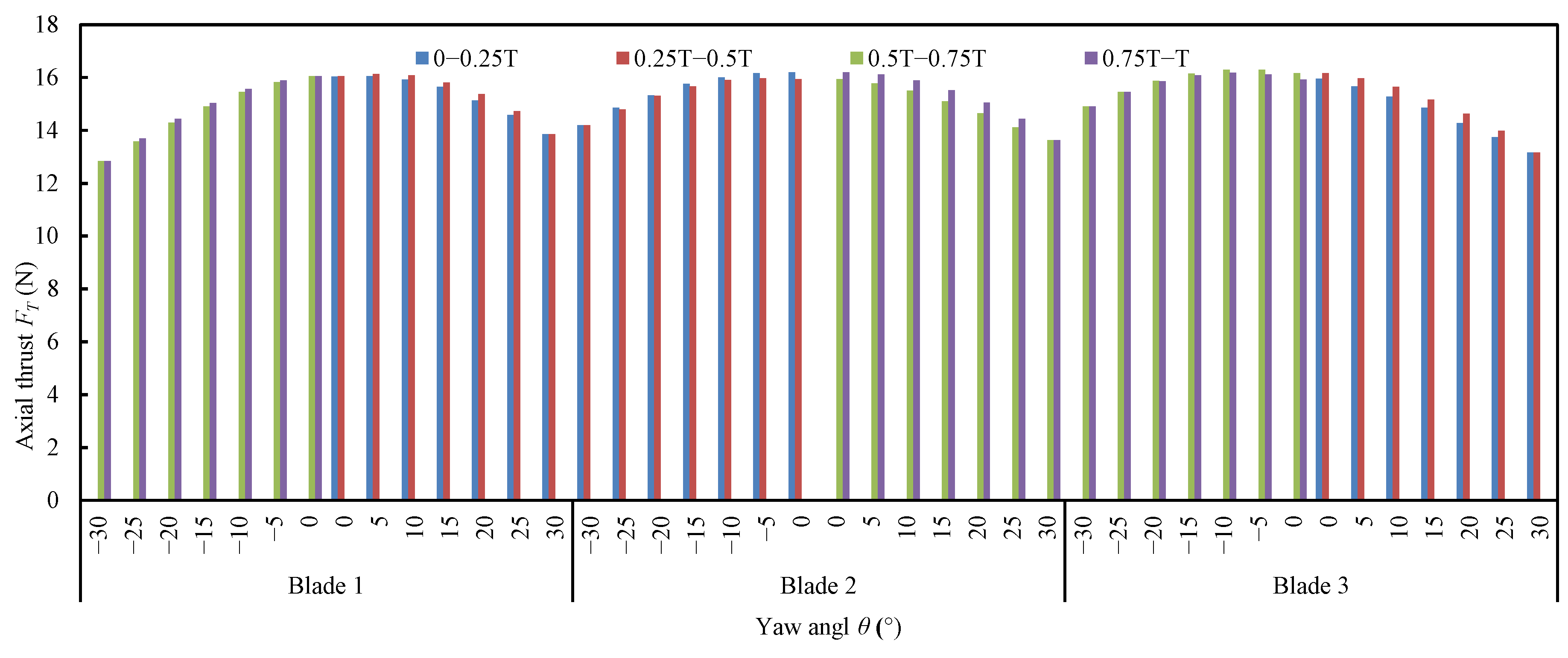


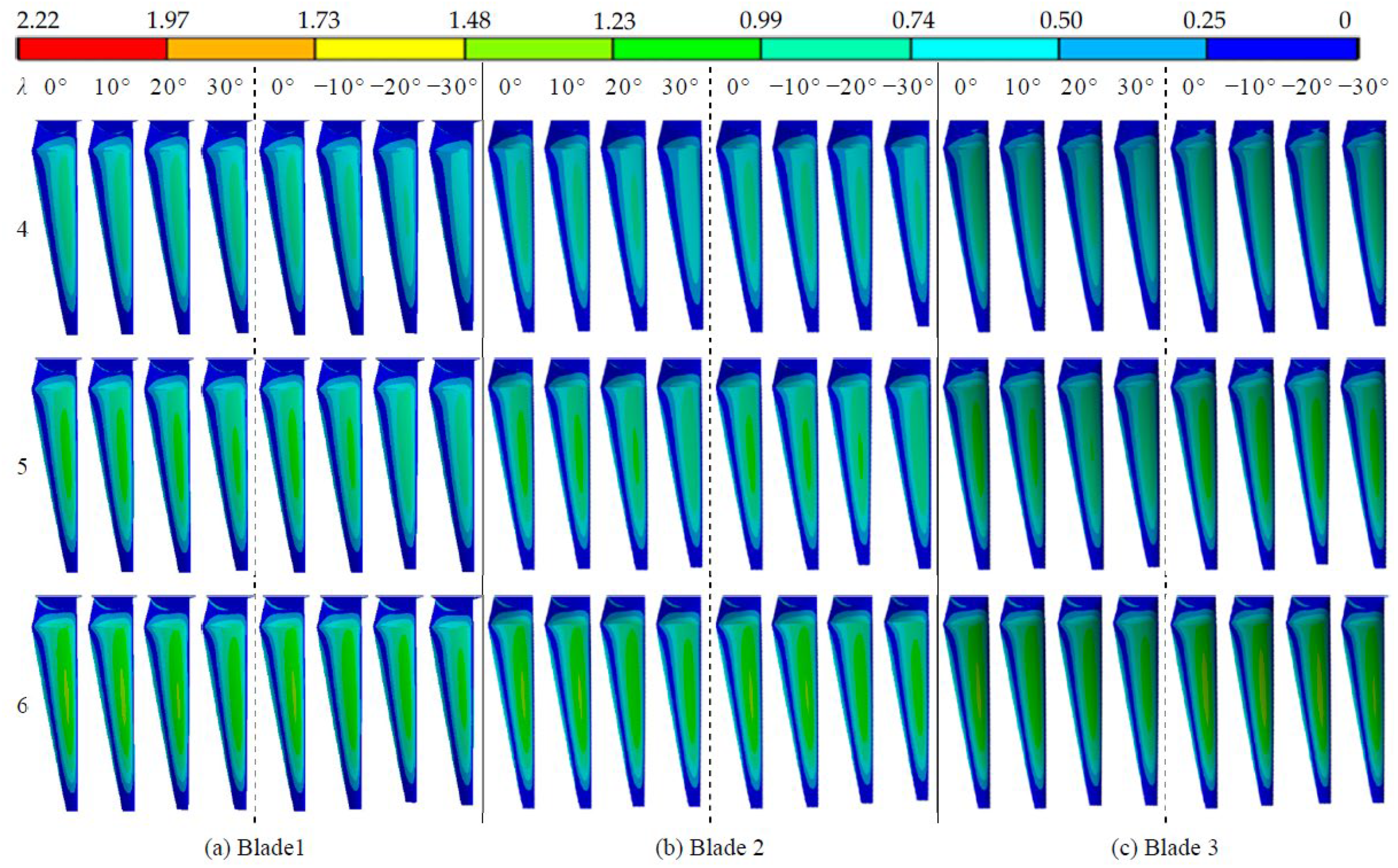
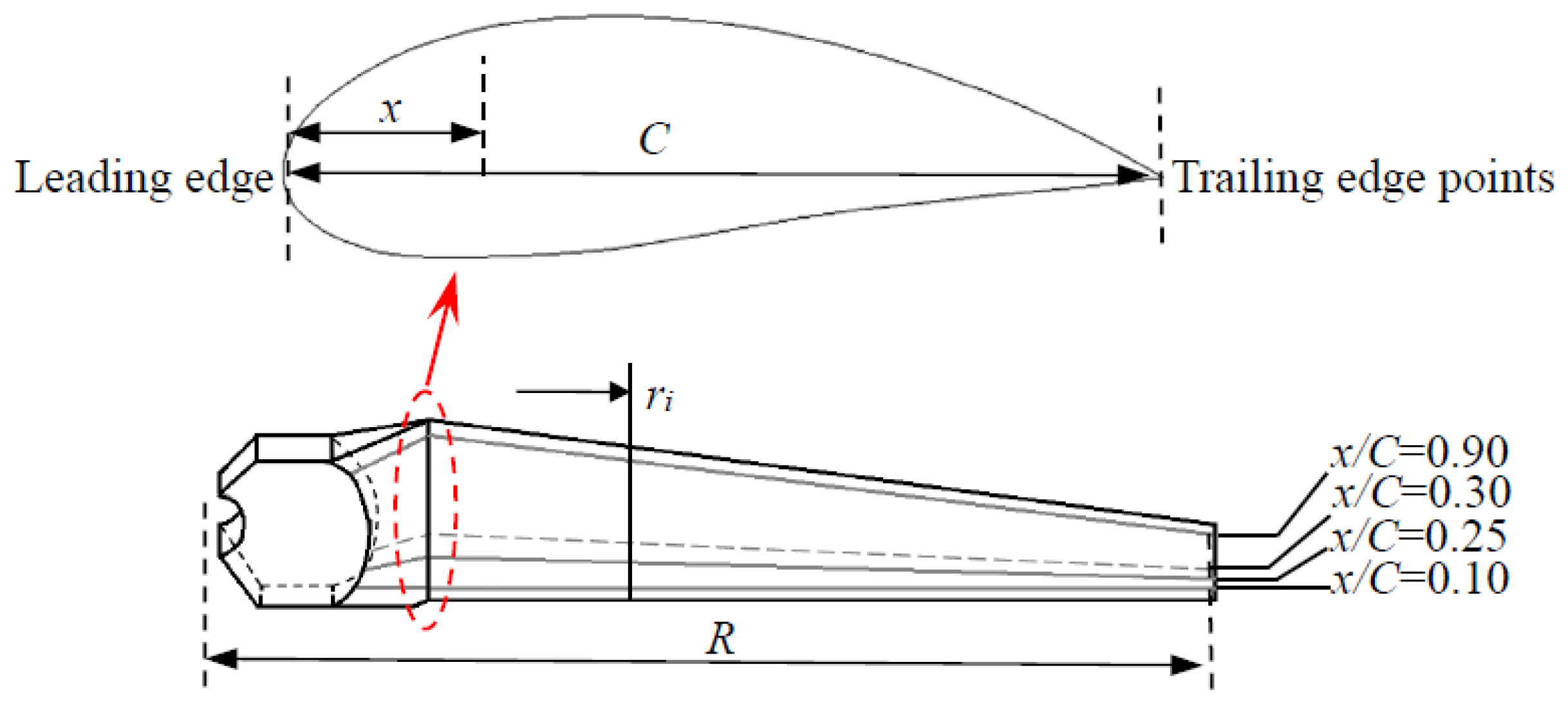
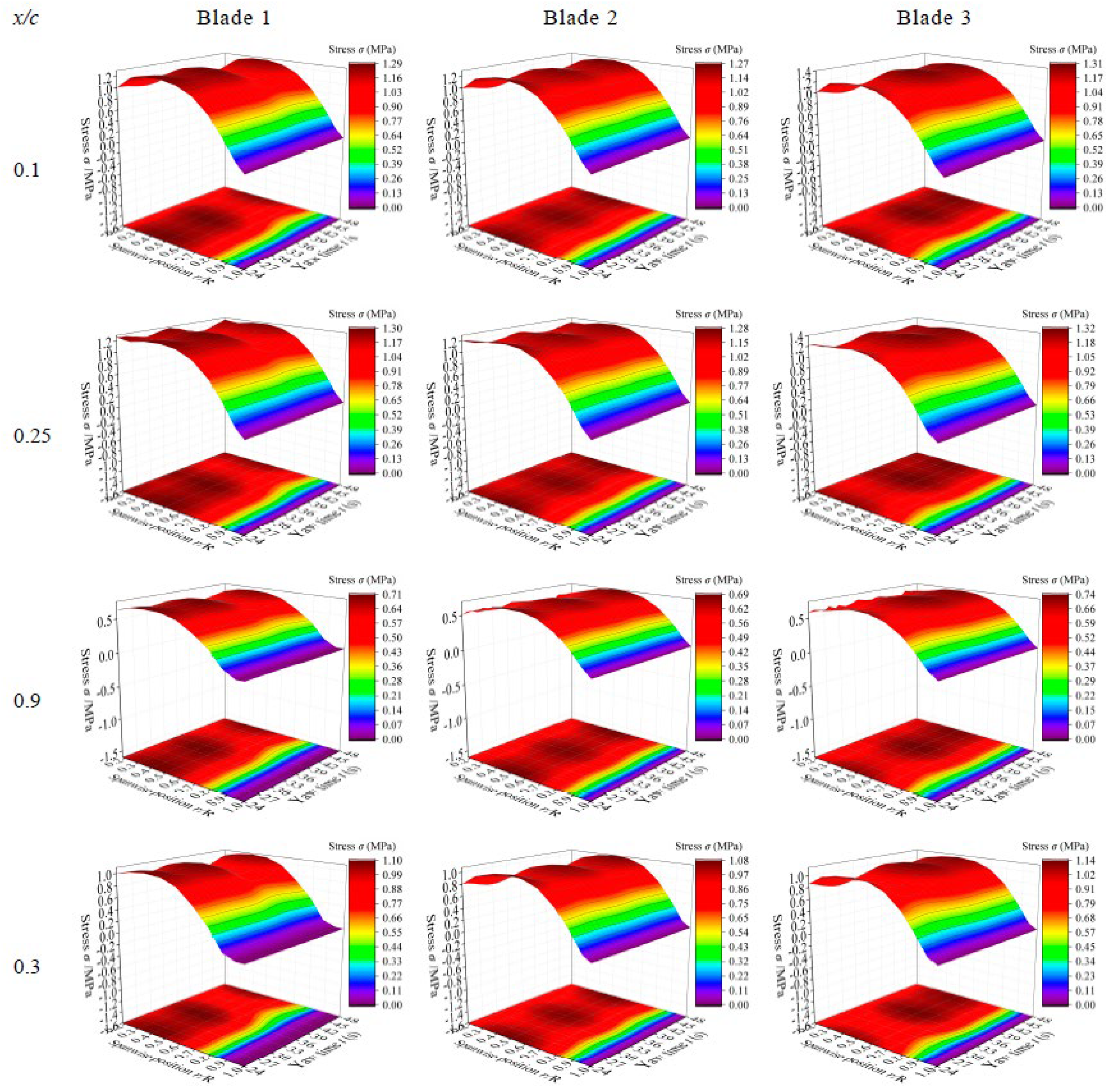
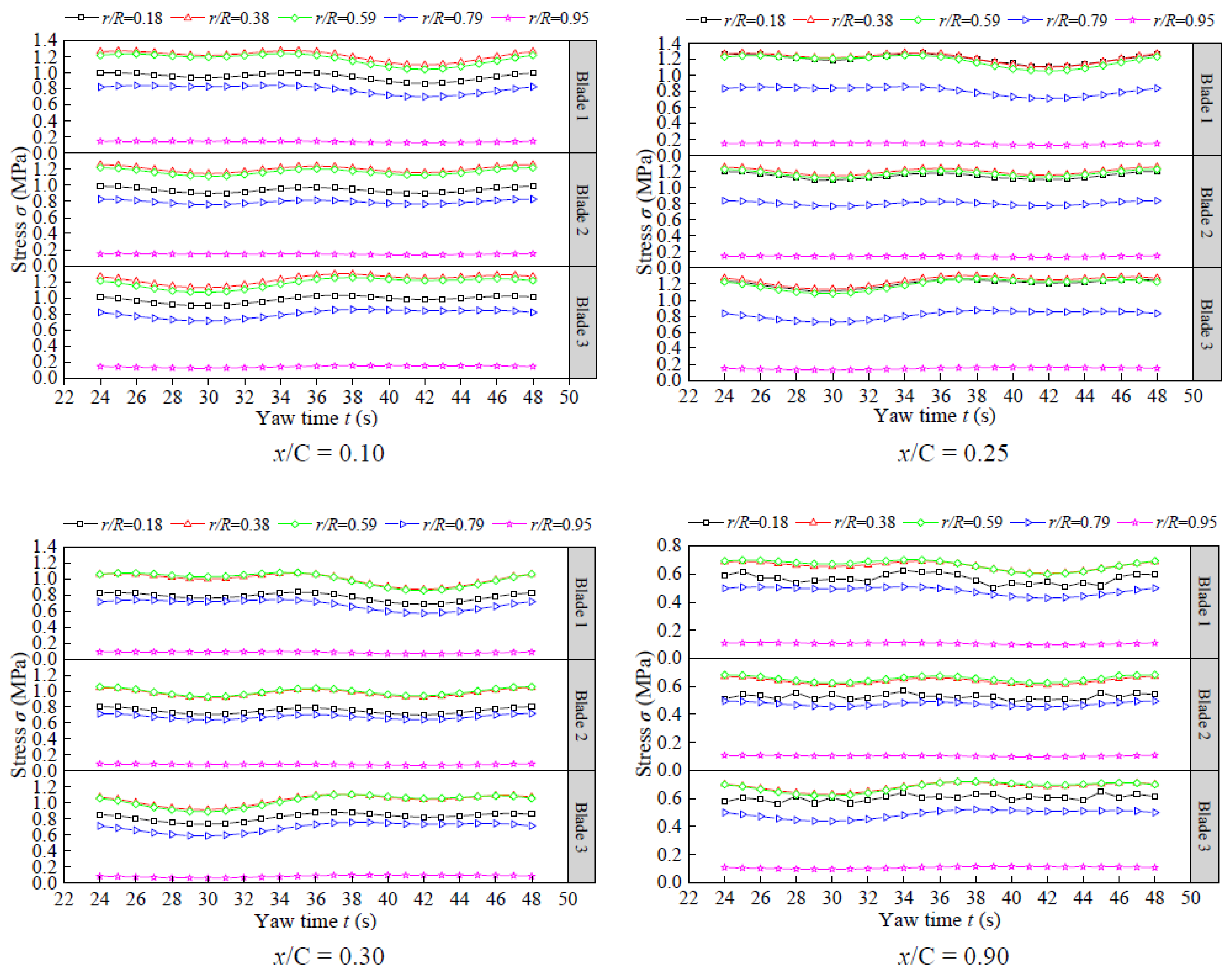
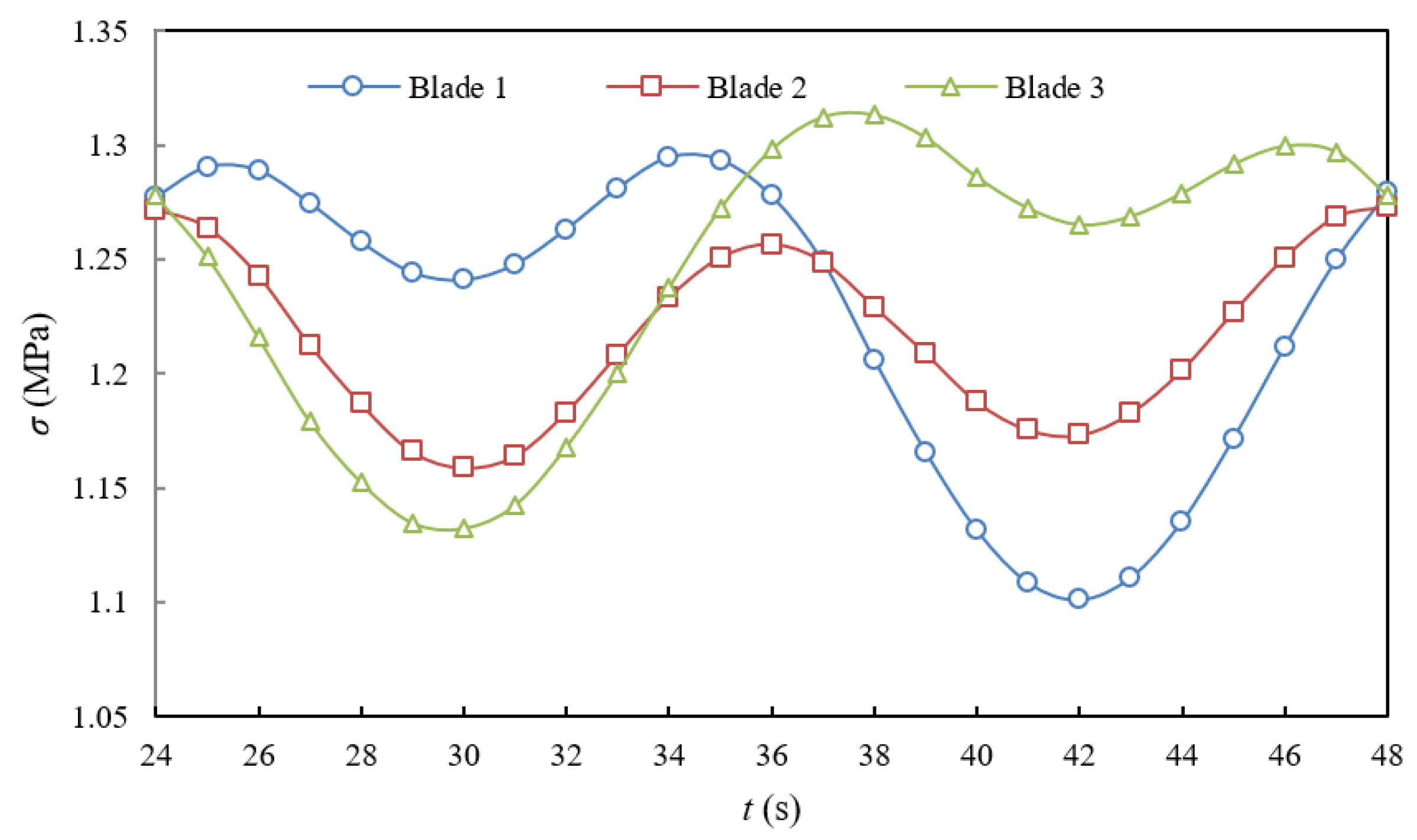

| Geometric Parameter | Symbol | Value |
|---|---|---|
| Aerofoil profile | – | NACA 4415 |
| Rotor orientation | – | Upwind |
| Blade number | N | 3 |
| Wind speed (m·s−1) | U | 8 |
| Rotor diameter (m) | D | 1.4 |
| Material | – | Wood composite |
| Elasticity modulus (GPa) | E | 4.8 |
| Poisson’s ratio | μ | 0.33 |
| Density (kg m−3) | ρ | 625 |
Disclaimer/Publisher’s Note: The statements, opinions and data contained in all publications are solely those of the individual author(s) and contributor(s) and not of MDPI and/or the editor(s). MDPI and/or the editor(s) disclaim responsibility for any injury to people or property resulting from any ideas, methods, instructions or products referred to in the content. |
© 2023 by the authors. Licensee MDPI, Basel, Switzerland. This article is an open access article distributed under the terms and conditions of the Creative Commons Attribution (CC BY) license (https://creativecommons.org/licenses/by/4.0/).
Share and Cite
Zhao, Y.; Gong, X.; Wang, J.; Zhang, L.; Bai, Y. Stress Characteristics of Horizontal-Axis Wind Turbine Blades under Dynamic Yaw. Appl. Sci. 2023, 13, 8418. https://doi.org/10.3390/app13148418
Zhao Y, Gong X, Wang J, Zhang L, Bai Y. Stress Characteristics of Horizontal-Axis Wind Turbine Blades under Dynamic Yaw. Applied Sciences. 2023; 13(14):8418. https://doi.org/10.3390/app13148418
Chicago/Turabian StyleZhao, Yuanxing, Xuan Gong, Jianwen Wang, Liru Zhang, and Yefei Bai. 2023. "Stress Characteristics of Horizontal-Axis Wind Turbine Blades under Dynamic Yaw" Applied Sciences 13, no. 14: 8418. https://doi.org/10.3390/app13148418
APA StyleZhao, Y., Gong, X., Wang, J., Zhang, L., & Bai, Y. (2023). Stress Characteristics of Horizontal-Axis Wind Turbine Blades under Dynamic Yaw. Applied Sciences, 13(14), 8418. https://doi.org/10.3390/app13148418






